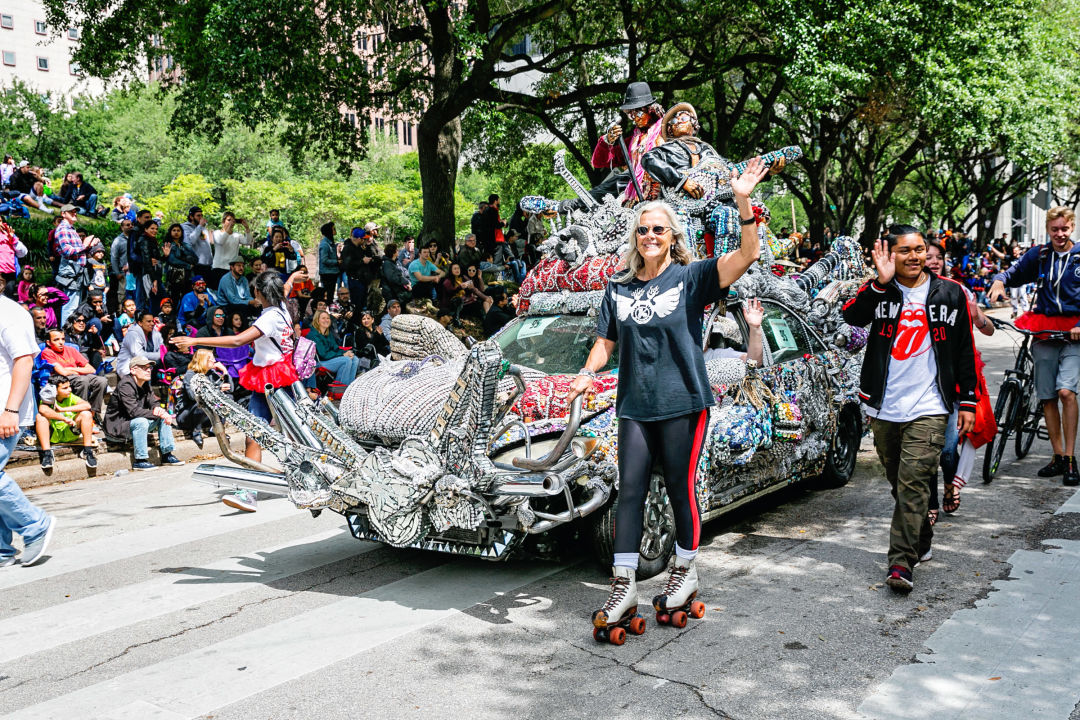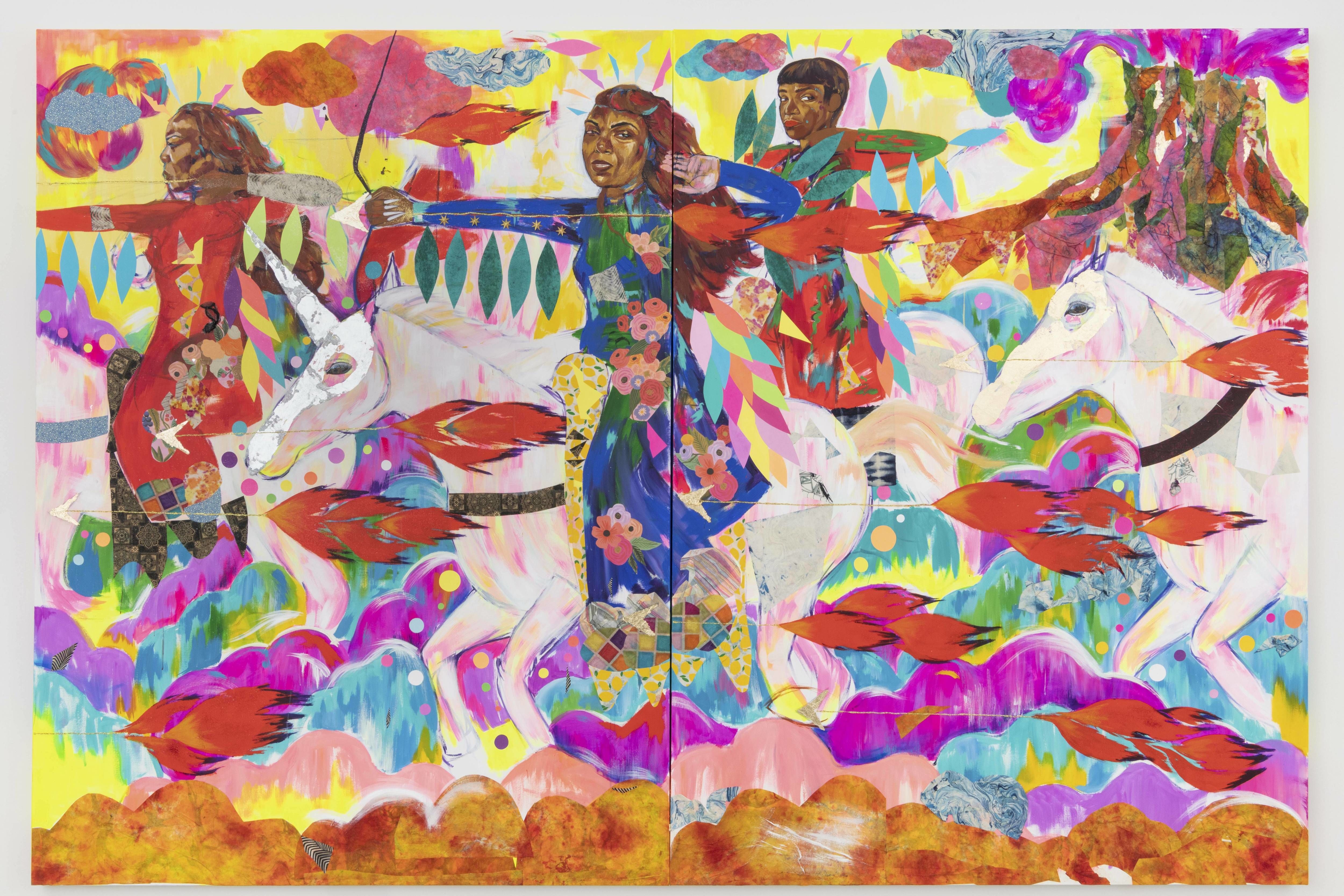How to Build an Art Car, According to an Expert

Rebecca Bass, the Orange Show's education manager, has been a major player among local art car enthusiasts since the very first parade took place in 1986.
April has arrived in the Bayou City, bringing with it wildflowers, patio weather, and the Orange Show’s 37th Annual Houston Art Car Parade and Festival. This year’s events are scheduled to take place April 11–14, and include not only the iconic parade, but the Main Street Drag caravan, the Legendary Art Car Ball, an awards ceremony, and more. Art cars are an indelible aspect of the city’s vibrant creative scene, but what exactly constitutes an “art car” anyway? What goes into making one, either for participation in the parade and competition or for simply adding a bit of whimsy to your life?
“[An art car] is an expression of yourself. I tend to lean towards ‘mobile sculptures,’” says Rebecca Bass, education manager at the Orange Show Center for Visionary Art. “People paint their cars and express themselves however it would be, if they got unicorns all over it or if it’s got some kind of wonderful abstract art all over it. It’s altering your motor vehicle to give laughs to people driving down the road. It’s like this mobile art gallery that you just checked out at a Walgreens.”
Bass has been a major player among art car enthusiasts since the very first parade took place in 1986. She estimates she’s participated in the building of 37 art cars during her career as an educator, first in public schools and then as part of the Orange Show’s management. Even after leaving the school system, Bass taught art car workshops to kids and teens until passing the torch down to her staffers.

She built her first art car in 1988 alongside a dozen of her middle school students. With a budget of only $200, half was spent on a used Volkswagen and the other half was spent on supplies to decorate it.
“We built this beautiful thing out of surgical gloves, and we made legs and arms out of foam from old couches and chairs that were left by the roadside,” Bass says. “We had a great time, and we were in the parade—the only school that had ever done anything like that. And we won the mayor’s cup.”
The core tenets of art car production that Bass has imparted to her students also stand true for anyone in the community hoping to craft one of their own. In fact, many of the children she taught went on to create art cars in adulthood. It starts with the simplest advice… but also the broadest.

Bass's art car "Atomic Dog" showcases a variety of construction techniques.
“You come up with a concept and you try to symbolize that concept somehow,” Bass advises. “We have a gentleman who, every year, puts Peeps all over his Jeep in different designs. Sometimes it’s the Mona Lisa. It’s been great. You just come up with a theme […] and then it just kind of springs from there.”
Some folks design everything on paper before beginning their art car projects, while others prefer to go straight to the production line. Both approaches are correct, though the latter involves some trial and error since there isn’t a blueprint to follow. As Bass points out, though, all a mistake means in the art car world is that the creator tries something else. The essence of creativity involves seeing obstacles as opportunities, after all.
She also notes that painted cars require sanding off the clear coat and layers of primer before applying the final design, something aspirant art car creators need to keep in mind. This helps ensure that the paint sticks to its metal canvas. More involved designs may entail some welding. Bass mentions working on film sets in the 1980s and how many of the early art car creators applied the skills they honed as sculptors, set designers, practical effects artists, and similar pursuits. Many of them worked with “one-pound bead foam” and “a synthetic stucco, called coal rib,” though Bass emphasizes that anything can be an art car material, citing Welsh artist Andy Hazell as an example. When visiting the Orange Show, he crafted what she refers to as a “lightweight” art car with wood on the inside and an outside composed of aluminum. Another one of the most memorable art cars she’s witnessed involves a “Tabernacle Choir” of singing Big Mouth Billy Bass.

The art car "It’s Only Rock and Roll But I Like It," an homage to the Rolling Stones, was constructed with the help of students from Heights High School.
Art cars intended for day-to-day use—a common sight in Houston neighborhoods, especially around parade time—require more pragmatic, road-safe designs than those purely intended for display or parade purposes.
“If [the art car] is going to be a parade vehicle, it can be as impractical as you want it,” Bass says. “You want wings to flap when you go down the road? That’s not really a practical thing to do if you're going to drive it every day. But if you’re going to take it out to play, it’s perfect.”
Always the arts educator, she advises anyone hoping to work on an art car that the most effective entries that go on display or participate in the parade are ones where “the masses have to understand what you’re saying.” Strong art is cohesive art, yet it may open itself up to alternate interpretations based on the viewers’ unique experiences and perspectives.

Bass's art car "Purple Reign" is dedicated to all things Prince.
“You want people to recognize or feel touched by something in your artwork; it doesn’t have to be what you’re trying to say,” Bass says. “They get connected to something inside of them through your art. I think that aspiring art car artists, students, and teachers should just do it.”
To Bass, the most important elements of an art car, no matter how simplistic or elaborate, are the friendships one builds while collaborating on the creative project. When the Art Car Museum shocked Houstonians by announcing its closure on April 28, she assured creators and fans that the art car community will continue as it always has, because it’s never been confined to just one space.
“You get to work side by side with people—and most people have help somewhere along the line on [their] art car—it becomes this giant, creative community,” she says. “It’s a place that’s much bigger than yourself.”




